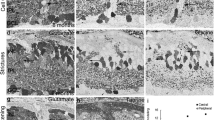Summary
The compound eye and the two most distal optic neuropils (lamina ganglionaris and medulla externa) of the Drosophila mutant w rdgB KS222were examined with transmission electron microscopes at conventional (60 kV) and high (0.8–1 MV) voltages. Eye tissue was sampled in the newly emerged and at 3, 7, and 21 days following eclosion. This mutant is known to show a light-induced degeneration of the peripheral retinular cells (R 1–6); the spectral sensitivity is altered and the threshold is increased reflecting the function of the central cells (R7, 8) which do not degenerate.
A totally normal appearing visual system (peripheral retina and optic neuropiles) was found in newly emerged adults. After 3 days the somata of some of the peripheral retinal cells are affected and all of their axons show degeneration. At one week the R 1–6 pathology is well advanced in both somal and axonal regions. In affected cells the cytoplasm is more or less uniformly electron dense and contains liposomes, lysosome-like bodies, myeloid figures and vacuoles suggesting autophagy. Such cytoplasm (noted at 3 and 7 days post-eclosion) exhibits an electron dense reticulum and degenerate mitochondria. Microvilli become more electron dense. Retinular axon terminals are electron opaque and lack synaptic vesicles with few if any presynaptic structures. Mitochondrial remains are barely recognizable. Transsynaptic degeneration was not found. After 3 weeks, the structure of R 1–6 in the peripheral retina (somata and rhabdomeres) is greatly reduced or lost while R7 and R8 and higher order neurons are not affected. The debris from cell bodies and axon terminals of R 1–6 seems diminished, so that some phagocytosis probably takes place along with gliosis in the lamina.
Similar content being viewed by others
References
Blest AD (1980) Photoreceptor membrane turnover in arthropods: Comparative studies of breakdown processes and their implications. In: Williams TP, Baker BN (eds) The effects of constant light on visual processes. Plenum Press, New York, pp 217–245
Boschek CB (1971) On the fine structure of the peripheral retina and lamina ganglionaris of the fly, Musca domestica. Z Zellforsch 118:369–409
Burkhardt D (1962) Spectral sensitivity and other response characteristics of single visual cells in the arthropod eye. Symp Soc Exp Biol 16:86–109
Carlson SD, Chi C (1979) The functional morphology of the insect photoreceptor. Ann Rev Entomol 24:379–416
Dietrich W (1909) Die Facettenaugen der Dipteren. Z Wiss Zool 92:465–539
Eckert H (1971) Die spektrale Empfindlichkeit des Komplexauges von Musca (Bestimmung aus Messaugen der optomotorischen Reaktion). Kybernetik 9:145–156
Griffiths GW (1979) Transport of glial cell acid phosphatase by endoplasmic reticulum into damaged axons. J Cell Sci 36:361–389
Griffiths GW, Boscheck CB (1976) Rapid degeneration of visual fibers following retinal lesions in the dipteran compound eye. Neurosci Lett 3:253–258
Harris WA, Stark WS (1977) Hereditary retinal degeneration in Drosophila melanogaster, A mutant defect associated with the phototransduction process. J Gen Physiol 69:261–291
Harris WA, Stark WS, Walker JA (1976) Genetic dissection of the photoreceptor system in the compound eye of Drosophila melanogaster. J Physiol 256:415–439
Hauser-Holschuh H (1975) Vergleichend quantitative Untersuchungen an den Sehganglien der Fliegen Musca domestica and Drosophila melanogaster. Doctoral dissertation. Eberhard-Karls-Universität Tübingen, Augsburg Blasaditsch
Heisenberg M (1979) Genetic approach to a visual system. In: Autrum H (ed) Comparative physiology and evolution of vision in invertebrates, A: Invertebrate photoreceptors. Springer-Verlag, Berlin, pp 665–679
Hotta Y, Benzer S (1970) Genetic dissection of the Drosophila nervous system by means of mosaics. Proc Natl Acad Sci USA 67:1156–1163
Hu KG, Stark WS (1980) The roles of Drosophila ocelli and compound eyes in phototaxis. J Comp Physiol 135:85–95
Miller GV, Hansen KN, Stark WS (1981) Phototaxis in Drosophila: R 1–6 input and interaction among ocellar and compound eye receptors. J Insect Physiol 27:813–819
Strausfeld NJ (1976) Atlas of an insect brain. Springer, Berlin, pp 212
Strausfeld NJ, Campos-Ortega JA (1977) Vision in insects: pathways possibly underlying neural adaptation and lateral inhibition. Science 195:894–897
Trujillo-Cenóz O, Melammed J (1966) Electron microscope observations on the peripheral and intermediate retinas of dipterans. In: Bernhard CG (ed) The functional organization of the compound eye. Pergamon Press, London, pp 339–361
Williams DS, Blest AD (1980) Extracellular shedding of photoreceptor membrane in the open rhabdom of a tipulid fly. Cell Tissue Res 205:423–438
Author information
Authors and Affiliations
Additional information
The present study was supported in large part by a Faculty Development Award from the University of Missouri, by NIH grant RO1-EY03408 to W.S.S., and a Hatch grant, Project 2100 to S.D.C. For the use of the HVEM we thank Professor Hans Ris, Dr. James Pawley, Dr. Damian Neuberger and Ms. Martha Bushlow, High Voltage Electron Microscope Laboratory, Dept. of Zoology, UW-Madison. Dr. Sheng Ming Chu and Dr. Che Chi, Department of Entomology, UW-Madison, provided help in ultramicrotomy and staining. Mr. Gary Gaard, Dept. of Plant Pathology, UW-Madison, is thanked for TEM guidance and Mr. Martin Garment, Department of Entomology, for darkroom assistance
Rights and permissions
About this article
Cite this article
Stark, W.S., Carlson, S.D. Ultrastructural pathology of the compound eye and optic neuropiles of the retinal degeneration mutant (w rdgB KS222) Drosophila melanogaster . Cell Tissue Res. 225, 11–22 (1982). https://doi.org/10.1007/BF00216214
Accepted:
Issue Date:
DOI: https://doi.org/10.1007/BF00216214




